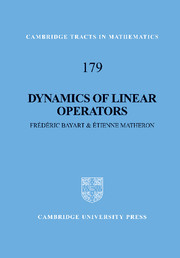Book contents
- Frontmatter
- Contents
- Introduction
- 1 Hypercyclic and supercyclic operators
- 2 Hypercyclicity everywhere
- 3 Connectedness and hypercyclicity
- 4 Weakly mixing operators
- 5 Ergodic theory and linear dynamics
- 6 Beyond hypercyclicity
- 7 Common hypercyclic vectors
- 8 Hypercyclic subspaces
- 9 Supercyclicity and the Angle Criterion
- 10 Linear dynamics and the weak topology
- 11 Universality of the Riemann zeta function
- 12 An introduction to Read-type operators
- Appendices
- References
- Notation
- Author index
- Subject index
2 - Hypercyclicity everywhere
Published online by Cambridge University Press: 10 December 2009
- Frontmatter
- Contents
- Introduction
- 1 Hypercyclic and supercyclic operators
- 2 Hypercyclicity everywhere
- 3 Connectedness and hypercyclicity
- 4 Weakly mixing operators
- 5 Ergodic theory and linear dynamics
- 6 Beyond hypercyclicity
- 7 Common hypercyclic vectors
- 8 Hypercyclic subspaces
- 9 Supercyclicity and the Angle Criterion
- 10 Linear dynamics and the weak topology
- 11 Universality of the Riemann zeta function
- 12 An introduction to Read-type operators
- Appendices
- References
- Notation
- Author index
- Subject index
Summary
Introduction
In this chapter, we prove several striking results showing that hypercyclicity is far from being an exotic phenomenon. In particular, we show that hypercyclic operators exist on any infinite-dimensional separable Fréchet space and that one can construct hypercyclic operators with “arbitrary” orbits. In the same spirit, we show that linear dynamics is in some sense as complicated as topological dynamics. We also discuss the size of the set of all hypercyclic operators on some given space X. Finally, we show that any Hilbert space operator may be written as the sum of two hypercyclic operators.
Mixing operators
When considering a strategy for constructing hypercyclic operators on an arbitrary “abstract” separable Banach space, one certainly has to keep in mind that some spaces have very few operators. Indeed, it is now well known that there exist (infinite dimensional) Banach spaces on which any operator has the form ⋋I + S, where S is strictly singular (for example, the so-called hereditarily indecomposable spaces; see Chapter 6 for some results concerning hypercyclic operators on such spaces). By a recent result of S. A. Argyros and R. Haydon [9], one can even encounter Banach spaces on which every operator has the form ⋋I + K, where K is a compact operator.
The examples of hypercyclic operators encountered in Chapter 1 are very far from being small perturbations of ⋋I. Yet, if hypercyclic operators are supposed to exist on any separable Banach space, it must be true that some operators of the form ⋋I + K are hypercyclic.
- Type
- Chapter
- Information
- Dynamics of Linear Operators , pp. 31 - 59Publisher: Cambridge University PressPrint publication year: 2009



